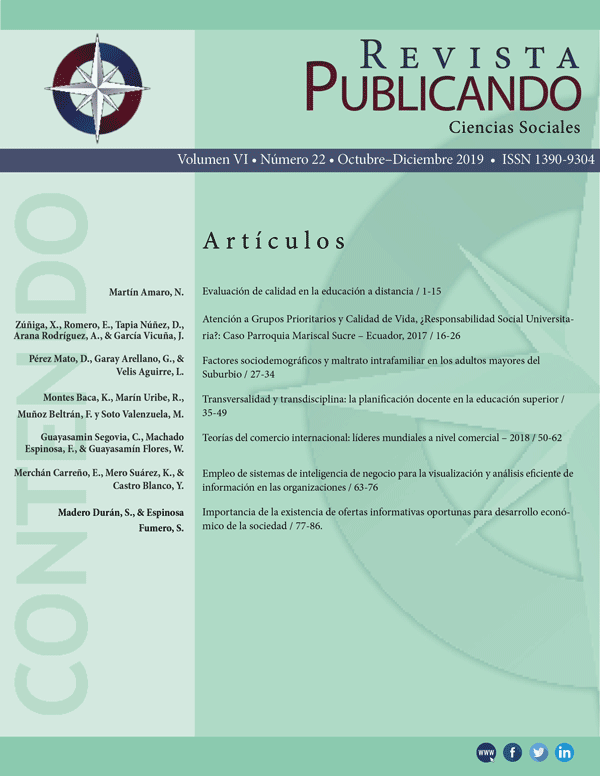Abstract
Abuse of the elderly has emerged as a social problem in the public sphere for a few years. Are few the investigations on this subject, although the Ecuadorian Constitution recognizes older adults as a group of priority attention, that represents 6.5% of the population of the country (2010 data), with an estimated increase of 18% by 2050, according to the Ministry of economic and social inclusion. The main objective of this work was to characterize the sociodemographic factors associated with family abuse of older adults in the Suburb sector. A retrospective descriptive study was carried out during the last semester of 2017. The sample was 100 older adults. The documentary analysis, the Mini-mental test, and a family risk assessment questionnaire were used. The results showed prevalence of intrafamilial abuse, mainly in the female sex. Poverty and material conditions, in general, were not associated with intrafamily abuse, which undoubtedly constitutes an alarming indicator of the current magnitude of this phenomenon in the 21st century, which could have a significant theoretical and social impact if found for further investigations.References
Cabreras, M. D. (2006). Caracterización del anciano. Estudios realizados en tres consultorios rurales del policlínico docente" Hermanos Cruz" [disertación]. Rev Elect Pinar del Río.
Camejo Lluch, R. y Mastrapa, E. (2017). Caracterización de la violencia familiar del adulto mayor perteneciente al CMF No. 5 (2015-2017). Córdoba: El Cid Editor.
Casas y Rodríguez, N. A. (2014). Caracterización de adultos mayores del municipio de Buenavista respecto a violencia intrafamiliar. Recuperado de: https://stadium.unad.edu.co/preview/UNAD.php?url=/bitstream/10596/2564/1/337 04370
Castro, P. (2016). El maltrato de personas mayores. España: Rev. Geronto, 2(6), 135-145.
Constitución de la República del Ecuador (2008, 20 de octubre). Registro Oficial 449.
García Rosique, R. M., Guisado Zamora, K., y Torres Triana, A. (2016). Maltrato intrafamiliar hacia el adulto mayor en el del Policlínico Reynold García de Versalles. Revista Médica Electrónica, 38(6), 826-836.
García, R.; Guisado, K., y Torres, A. (2016). Maltrato intrafamiliar hacia el adulto mayor en el del Policlínico Reynold García de Versalles. Revista Médica Electrónica, 38(6), 826-836.
Gómez, F. (2015). El maltrato a las personas mayores. Madrid: El Imserso. Recuperado de http://www.imserso.es/InterPresent2/groups/imserso/documents/binario/enlace23_26_31maltratoppmm.pdf
Hernández Triana, M. (2014). Envejecimiento. Revista Cubana de Salud Pública, 40, 361-378. Recuperado de: http://scielo.sld.cu/scielo.php?script=sci_arttext&pid=S086434662014000400011.
Instituto colombiano de bienestar familiar (2012). Programa de atención al adulto mayor. Segundo documento de respuestas a las observaciones al pliego de condiciones definitivo del programa nacional de alimentación para el adulto mayor “Juan Luis Londoño de la cuesta” -PNAAM-. Recuperado de: https://www.icbf.gov.co/sites/default/files/segundosegunda12.pdf.
Martínez-Moreno, E., y Bermúdez-Pérez, M. D. L. P. (2016). Maltrato psicológico hacia los mayores: variables a tratar. Revista Española de Comunicación en Salud, 7 (1), 143-153.
Organización Mundial de la Salud (2015a). Informe mundial sobre el envejecimiento y la salud (Resumen). Luxemburgo: OMS. Recuperado de https://apps.who.int/iris/bitstream/handle/10665/186471/WHO_FWC_ALC_15.01_%20spa.pdf;jsessionid=9411A1CC40389EFAF418863D5E93E57D?sequence=1.
__________________ (2015b). El maltrato de las personas mayores. Cap. 5. Informe mundial sobre la violencia y la salud. Ginebra: OMS. Disponible en: http://www1.paho.org/Spanish/AM/PUB/capitulo_5.pdf.
Ricaurte, A. I. (2015). Violencia contra el adulto mayor. Forensis datos para la vida. Bogotá: Instituto Nacional de Medicina Legal y Ciencias Forenses.
Silva-Fhon, Jack Roberto, Del Río-Suarez, Antonia Defilia, Motta-Herrera, Silvia Natividad, Coelho Fabricio-Wehbe, Suzele Cristina y Partezani-Rodrigues, Rosalina Aparecida. (2015). Violencia intrafamiliar en el adulto mayor que vive en el distrito de Breña, Perú. Revista de la Facultad de Medicina, 63(3), 367-375. https://dx.doi.org/10.15446/revfacmed.v63n3.44743
Vilcapaza, D., Quevedo, D., ílvarez, A. y Huaco, J. (2017) Problemática de la familia en el Perú. Arequipa: UNAS. Monografías.com. Recuperado de: https://www.monografias.com/docs114/problematica-familia-peru/problematica-familia-peru2.shtml.
You are free to:
Share — copy and redistribute the material in any medium or format.
Adapt — remix, transform, and build upon the material.
The licensor cannot revoke these freedoms as long as you follow the license terms.
Under the following terms:
Attribution — You must give appropriate credit, provide a link to the license, and indicate if changes were made. You may do so in any reasonable manner, but not in any way that suggests the licensor endorses you or your use.
NonCommercial — You may not use the material for commercial purposes.
ShareAlike — If you remix, transform, or build upon the material, you must distribute your contributions under the same license as the original.
No additional restrictions — You may not apply legal terms or technological measures that legally restrict others from doing anything the license permits.
